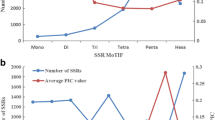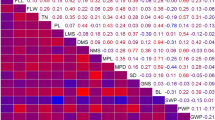Abstract
Alfalfa (Medicago sativa L.) is an internationally significant forage crop. Forage yield, lodging resistance and spring vigor are important agronomic traits conditioned by quantitative genetic and environmental effects. The objective of this study was to identify quantitative trait loci (QTL) and molecular markers associated with increased forage yield, resistance to lodging, and spring vigor. A backcross population composed of 128 progeny was developed by crossing the breeding parents DW000577 (lodging susceptible) and NL002724 (lodging-resistant) and back-crossing an individual F1 plant to the maternal parent (i.e. DW000577). A linkage map of NL002724 was developed based upon the segregation of 236 AFLP, SRAP, and SSR markers among the backcross progeny. The markers were distributed among 14 linkage groups, covering an estimated recombination distance of 1497.6 centiMorgans (cM). Replicated clones of both parents and backcross progeny were evaluated in the field for estimated forage yield, lodging, and spring vigor in Washington and Wisconsin during 2007 and 2008. Significant QTL were found for all three traits. In particular, two QTL for lodging resistance were identified that explained ≥14 % of trait variation, and were significant in all years and locations. Major QTL explaining over 25 % of trait variation for forage yield were detected in multiple environments at two separate locations on chromosome III. Several QTL for spring vigor were located in the same or similar positions as QTL for forage yield, possibly explaining the significant correlation between these traits. Molecular markers associated with the aforementioned QTL were also identified.




Similar content being viewed by others
References
Banniza S, Hashemi P, Warkentin TD, Vendenberg A, Davis AR (2005) The relationships among lodging, stem anatomy, degree of lignifications, and resistance to mycosphaerella blight in field pea (Pisum sativum). Can J Bot 83:954–967
Buntjer J (2000) Cross checker: computer assisted scoring of AFLP data. Plant and animal genome conference VIII, San Diego CA, 9-12 Jan 2000
Busbice TH, Wilsie CP (1966) Inbreeding depression and heterosis in autotetraploids with application to Medicago sativa L. Euphytica 15:52–67
Campbell NA, Arnold GW (1973) The visual assessment of pasture yield. Aust J Exp Agric Anim Husb 13:263–267
Elshire RJ, Glaubitz JC, Sun Q, Poland JA, Kawamoto K, Buckler ES, Mitchell SE (2011) A robust, simple genotyping-by sequencing (GBS) approach for high diversity species. PLoS ONE 6:e19379
Hackett CA, Milne I, Bradshaw JE, Luo Z (2007) TetraploidMap for windows: linkage map construction and QTL mapping in autotetraploid species. J Hered 98:727–729
Han Y, Kang Y, Torres-Jerez I, Cheung F, Town CD, Zhao PX, Udvardi MK, Monteros MJ (2011) Genome-wide SNP discovery in tetraploid alfalfa using 454 sequencing and high resolution melting analysis. BMC Genom 12:350–360
Johnson D, Miller D, Sharpee D, Darling M, Hoard G, Undersander D (2006) Standability expression (lodging resistance): an evaluation method to determine the percentage of erect stems (>45°). www.naaic.org/stdtests/standability.html. Accessed 8 Aug 2013
Li G, Quiros CF (2001) Sequence-related amplified polymorphism (SRAP), a new marker system based on a simple PCR reaction: its application to mapping and gene tagging in Brassica. Theor Appl Genet 103:455–461
Li X, Wei Y, Moore KJ, Michaud R, Viands DR, Hansen JL, Acharya A, Brummer EC (2011) Association mapping of biomass yield and stem composition in a tetraploid alfalfa breeding population. The Plant Genome 4:24–35
Maureira-Butler IJ, Udall JA, Osborn TC (2007) Analyses of a multi-parent population derived from two diverse alfalfa germplasms: testcross evaluations and phenotype-DNA associations. Theor Appl Genet 115:859–867
Miklas PN, Hauf DC, Henson RA, Grafton KF (2004) Inheritance of ICA Bunsi-derived resistance to white mold in a navy × pinto bean cross. Crop Sci 44:1584–1588
O’Donovan M, Dillon P, Rath M, Stakelum G (2002) Visual assessment of herbage mass. Ir J Agric Food Res 41:17–27
Pennsylvania State University (2011) Harvest management of alfalfa. www.forages.psu.edu/topics/hay_silage/management/alfalfa.html. Accessed 10 Aug 2013
Rampling LR, Harker N, Shariflou MR, Morell MK (2001) Detection and analysis systems for microsatellite markers in wheat. Aust J Agric Res 52:1131–1141
Robins JG, Bauchan GR, Brummer EC (2007) Genetic mapping forage yield, plant height, and regrowth at multiple harvests in tetraploid alfalfa (Medicago sativa L.). Crop Sci 47:11–18
Samac DA, Jung HG, Lamb JF (2006) Development of alfalfa (Medicago sativa L.) as a feedstock for production of ethanol and other bioproducts. In: Minteer S (ed) Alcoholic fuels. CRC Press, Boca Raton, pp 79–98
Schuelke M (2000) An economic method for the fluorescent labeling of PCR fragments. Nature Biotechnol 18:233–234
Sledge MK, Ray IM, Jiang G (2005) An expressed sequence tag SSR map of tetraploid alfalfa (Medicago sativa L.). Theor Appl Genet 111:980–992
Tar’an B, Warkentin T, Somers DJ, Miranda D, Vandenberg A, Blade S, Woods S, Bing D, Xue A, DeKoeyer D, Penner G (2003) Quantitative trait loci for lodging resistance, plant height and partial resistance to mycosphaerella blight in field pea (Pisum sativum L.). Theor Appl Genet 107:1482–1491
Ud-Din N, Carver BF, Krenzer EG (1993) Visual selection for forage yield in winter wheat. Crop Sci 33:41–45
Voorrips RE (2002) MapChart: software for the graphical presentation of linkage maps and QTLs. J Hered 93:77–78
Vos P, Hogers R, Bleeker M, Reijans M, van de Lee T, Hornes M, Fijters A, Pot J, Peleman J, Kuiper M, Zabeau M (1995) AFLP: a new technique for DNA fingerprinting. Nucleic Acids Res 23:4407–4414
Wilsie CP (1950) Effect of inbreeding on fertility and vigor of alfalfa. Agron J 50:182–185
Yang SS, Tu Z, Cheung F, Xu W, Lamb JF, Jung H-J, Vance C, Gronwald J (2011) Using RNA-Seq for gene identification, polymorphism detection and transcript profiling in two alfalfa genotypes with divergent cell wall composition in stems. BMC Genom 12:199–217
Zhu H, Choi H-K, Cook DR, Shoemaker RC (2005) Bridging model and crop legumes through comparative genomics. Plant Physiol 137:1189–1196
Author information
Authors and Affiliations
Corresponding author
Electronic supplementary material
Below is the link to the electronic supplementary material.
Rights and permissions
About this article
Cite this article
McCord, P., Gordon, V., Saha, G. et al. Detection of QTL for forage yield, lodging resistance and spring vigor traits in alfalfa (Medicago sativa L.). Euphytica 200, 269–279 (2014). https://doi.org/10.1007/s10681-014-1160-y
Received:
Accepted:
Published:
Issue Date:
DOI: https://doi.org/10.1007/s10681-014-1160-y




